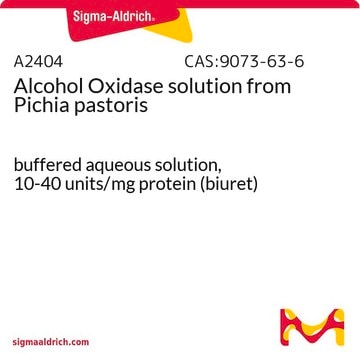F5152
D-Fructose Dehydrogenase from Gluconobacter industrius
lyophilized powder, 400-1,200 units/mg protein
Synonym(s):
D-Fructose:(acceptor) 5-oxidoreductase
Sign Into View Organizational & Contract Pricing
All Photos(2)
About This Item
CAS Number:
MDL number:
UNSPSC Code:
12352204
NACRES:
NA.54
Recommended Products
form
lyophilized powder
Quality Level
specific activity
400-1,200 units/mg protein
mol wt
140 kDa
composition
Protein, ≤10% Lowry
shipped in
wet ice
storage temp.
−20°C
Looking for similar products? Visit Product Comparison Guide
Application
D-fructose dehydrogenase is used as a biosensor to detect the presence of D-fructose.
Fructose dehydrogenase (FDH) is used in a number of basic research projects to examine the electrochemical properties of enzyme-catalyzed electrode reactions called bioelectrocatalysis. D-fructose dehydrogenase has been used in a study that contributed towards a convenient method for measuring rare sugars, monosaccharides, for applications in the bio-industry. A direct electron transfer reaction of d-fructose dehydrogenase adsorbed on a porous carbon electrode surface has been used to describe a batch-type coulometric d-fructose biosensor.
Biochem/physiol Actions
D-fructose dehydrogenase catalyzes the oxidation of D-fructose to 5-keto-D-fructose.
Fructose dehydrogenase (FDH) is a heterotrimeric membrane-bound enzyme commonly seen in various Gluconobacter sp. especially in Gluconobacter japonicus (Gluconobacter industrius). It has a molecular mass of ca. 140 kDa, consisting of subunits I (67kDa), II (51 kDa), and III (20 kDa) and catalyzes the oxidation of D-fructose to produce 5-keto-D-fructose. The enzyme is a flavoprotein-cytochrome c complex with subunits I and II covalently bound to flavin adenine dinucleotide (FAD) and heme C as prosthetic groups, respectively.
Unit Definition
One unit will convert 1.0 μmole D-fructose to 5-ketofructose per min at pH 4.5 at 37 °C.
Physical form
Lyophilized powder containing citrate-phosphate buffer salts, TRITON® X-100, and stabilizer
Storage Class Code
11 - Combustible Solids
WGK
WGK 3
Flash Point(F)
Not applicable
Flash Point(C)
Not applicable
Personal Protective Equipment
dust mask type N95 (US), Eyeshields, Gloves
Certificates of Analysis (COA)
Search for Certificates of Analysis (COA) by entering the products Lot/Batch Number. Lot and Batch Numbers can be found on a product’s label following the words ‘Lot’ or ‘Batch’.
Already Own This Product?
Find documentation for the products that you have recently purchased in the Document Library.
Seiya Tsujimura et al.
Analytical chemistry, 81(22), 9383-9387 (2009-11-17)
This paper describes a batch-type coulometric d-fructose biosensor based on direct electron transfer reaction of d-fructose dehydrogenase (FDH) adsorbed on a porous carbon electrode surface. The adsorbed-FDH electrodes catalyzed the electrochemical two-electron oxidation of d-fructose to 5-keto-d-fructose without a mediator.
Determination of seminal fructose using D-fructose dehydrogenase.
K Nakashima et al.
Clinica chimica acta; international journal of clinical chemistry, 151(3), 307-310 (1985-10-15)
Shukun Yu et al.
Biochimica et biophysica acta, 1760(9), 1314-1322 (2006-07-11)
Anhydrofructose (AF) pathway describes the catabolism of alpha-1,4-glucans of glycogen, starch and maltosaccharides to various metabolites via the central intermediate AF. The reaction sequence of the pathway consists of more than 10 enzymatic steps. This pathway occurs in certain bacteria
Shota Kawai et al.
Applied and environmental microbiology, 79(5), 1654-1660 (2013-01-01)
A heterotrimeric flavoprotein-cytochrome c complex fructose dehydrogenase (FDH) of Gluconobacter japonicus NBRC3260 catalyzes the oxidation of d-fructose to produce 5-keto-d-fructose and is used for diagnosis and basic research purposes as a direct electron transfer-type bioelectrocatalysis. The fdhSCL genes encoding the
Yuko Sasaki et al.
Analytical biochemistry, 417(1), 129-135 (2011-06-29)
The catalytic activity of a membrane-bound enzyme, d-fructose dehydrogenase (FDH), at the polarized oil/water (O/W) interface was studied. Multisweep cyclic voltammetry and ac voltammetry were carried out to show the irreversible adsorption of FDH at the interface. Using the thusly
Our team of scientists has experience in all areas of research including Life Science, Material Science, Chemical Synthesis, Chromatography, Analytical and many others.
Contact Technical Service






